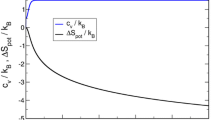Abstract
It is assumed that orientation fluctuations for molecules in a liquid form an uncorrelated Markov process, and an expression is derived in quadratures for the initial chemical polarization of the electrons formed by the triplet mechanism. The expression applies for any magnetic field strength and solvent viscosity. If the molecular rotations are slow and the magnetic field is weak, one can perform numerical calculations on the electron chemical polarization.
Similar content being viewed by others
Literature cited
A. L. Buchachenko, R. Z. Sagdeev, and K. M. Salikhov, Magnetic and Spin Effects in Chemical Reactions [in Russian], Nauka, Novosibirsk (1976).
P. W. Atkins and G. T. Evans, “Electron spin polarization in a rotating triplet,” Mol. Phys., 27, No. 6, 1633–1644 (1974).
P. J. Hore and K. A. McLauchlan, “A time resolved photo-CIDEP study of electron transfer in durosemiquinone radicals,” ibid., 42, No. 5, 1009–1026 (1981).
J. B. Pedersen and J. H. Freed, “Theory of chemically induced dynamic electron polarization. 3. Initial triplet polarization,” J. Chem. Phys., 62, No. 5, 1706–1711 (1975).
Yu. A. Serebrennikov, S. I. Temkin, and A. I. Burshtein, “Infrared and Raman spectra of a linear rotator in the fluctuating liquid cage model,” Chem. Phys., 81, No. 1/2, 31–40 (1983).
K. A. Valiev and E. N. Ivanov, “Rotational brownian motion,” Usp. Fiz. Nauk, 109. No. 1, 31–64 (1973).
A. I. Burshtein and Yu. S. Oseledchik, “Relaxation in a system with suddenly changing perturbations in the presence of correlation between successive values,” Zh. Éksp. Teor. Fiz., 51, No. 4, 1071–1083 (1966).
A. I. Burshtein, Lectures for the Quantum Kinetics Course [in Russian], Part 1, Novosibirsk. Universitet, Novosibirsk (1968).
I. V. Aleksandrov, Theory of Magnetic Relaxation [in Russian], Nauka, Moscow (1975).
D. A. Varshalovich, A. N. Moskalev, and V. K. Khersonskii, The Quantum Theory of Angular Momentum [in Russian], Nauka, Leningrad (1975).
G. T. Evans, “A generalized Redfield equation with initial spin-lattice correlation. An application to the triplet mechanism of CIDEP,” Mol. Phys., 31, No. 5, 1337–1343 (1976).
Author information
Authors and Affiliations
Additional information
Translated from Teoreticheskaya i Éksperimental'naya Khimiya, Vol. 22, No. 2, pp. 203–206, March–April, 1986.
Rights and permissions
About this article
Cite this article
Serebrennikov, Y.A., Minaev, B.F., Mukhin, R.R. et al. Calculating chemical electron-polarization in triplet-molecule reactions. Theor Exp Chem 22, 189–192 (1986). https://doi.org/10.1007/BF00519191
Received:
Issue Date:
DOI: https://doi.org/10.1007/BF00519191



